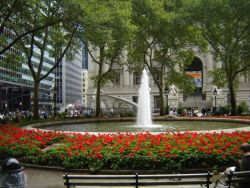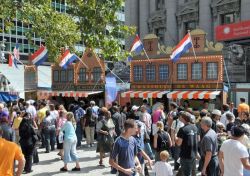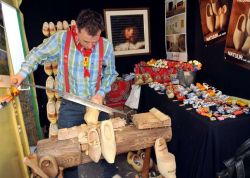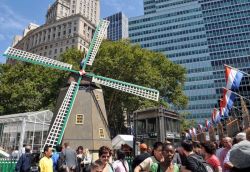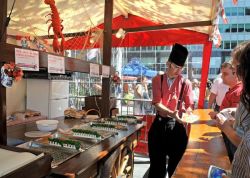Bowling Green
The Daily Plant : Tuesday, March 17, 2009
Parks Celebrates The 276th Anniversary Of Bowling Green Park
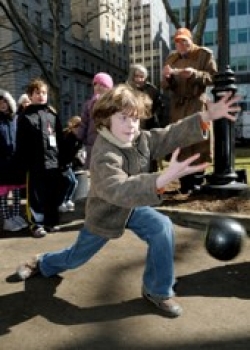
Photo by Daniel Avila
On March 12, Parks & Recreation Commissioner Adrian Benepe joined City Council Member Alan Gerson, former Parks Commissioner Henry Stern, Manhattan Borough Historian Michael Miscione, and the Bowling Green Association to celebrate the 276th anniversary of Bowling Green Park, New York City’s oldest park. The event’s festivities included a lawn bowling demonstration by the New York Lawn Bowling Club for students from P.S. 234.
According to tradition, Bowling Green served as the council ground for Native American tribes and is reputed to be the site of the legendary sale of Manhattan to Peter Minuit in 1626. The Dutch called the area “the Plain” and used it for several purposes. It was the beginning of Heere Staat (High Street, now Broadway)—a trade route that extended north through Manhattan and the Bronx. It was also the site of a parade ground, meeting place and cattle market. In 1686 the site became public property when the City Charter put all “waste, vacant, unpatented and unappropriated lands” under municipal domain.
Bowling Green was first designated as a park on March 12, 1733, when it was offered for rent at the cost of one peppercorn per year. Lessees John Chambers, Peter Bayard and Peter Jay were responsible for improving the site with grass, trees and a wood fence “for the beauty and ornament of the said Street as well as for the recreation and delight of the inhabitants of this City.” A gilded lead statue of King George III was erected there in 1770 and the iron fence (now a New York City landmark) was installed in 1771. On July 9, 1776, after the first public reading in New York State of the Declaration of Independence, the monument was toppled by angry citizens, dragged up Broadway, sent to Connecticut, melted down and recast as ammunition. Portions of the statue are held by the Museum of the City of New York and the New York Historical Society (which also possesses musket balls made from the statue’s lead).
By the late 18th century, Bowling Green marked the center of New York’s most fashionable residential area, surrounded by rows of Federal-style townhouses. In 1819, the Common Council voted that neighbors could plant and tend the area in return for the exclusive use of the park by their families. By mid-century, shipping offices inhabited the old townhouses, and the park was returned to more public use. Monuments installed in the park in the 19th century include two fountains, which no longer exist, and, in 1896, a statue of New York’s first mayor, Abraham De Peyster by the artist George Bissell.
In the first decade of the 20th century, Bowling Green was disrupted by the construction of the IRT subway. The park was rebuilt as part of citywide improvements made in preparation for visitors to the 1939 World’s Fair. Renovations to Bowling Green included removing the fountain basin, relocating the interior walkways, installing new benches and providing new plantings. Mayor Fiorello LaGuardia, Parks Commissioner Robert Moses, members of the Board of Estimate and local businessmen participated in the rededication ceremony, held April 6, 1939. Despite unseasonably late snow, the ceremony included a demonstration of colonial-era lawn bowling.
A 1976 capital renovation restored Bowling Green to its 18th-century appearance. Publisher and philanthropist George Delacorte donated the park’s central fountain. Since December 1989, the statue of Charging Bull has been on display at the north end of the park. Its sculptor, Arturo DiModica, says the three-and-a-half-ton bronze figure represents “the strength, power and hope of the American people for the future.” The park was renovated again in 2004 as part of the effort to improve Lower Manhattan parks after the attacks of September 11, 2001.
QUOTATION FOR THE DAY
“Oh, the music in the air!
An' the joy that's ivrywhere -
Shure, the whole blue vault of heaven is wan grand triumphal arch,
An' the earth below is gay
Wid its tender green th'-day,
Fur the whole world is Irish on the Seventeenth o' March!”
Thomas Augustin Daly
(1871–1948)
Check out your park's Vital Signs
Clean & Safe
Green & Resilient
Empowered & Engaged Users
Share your feedback or learn more about how this park is part of a
Vital Park System

